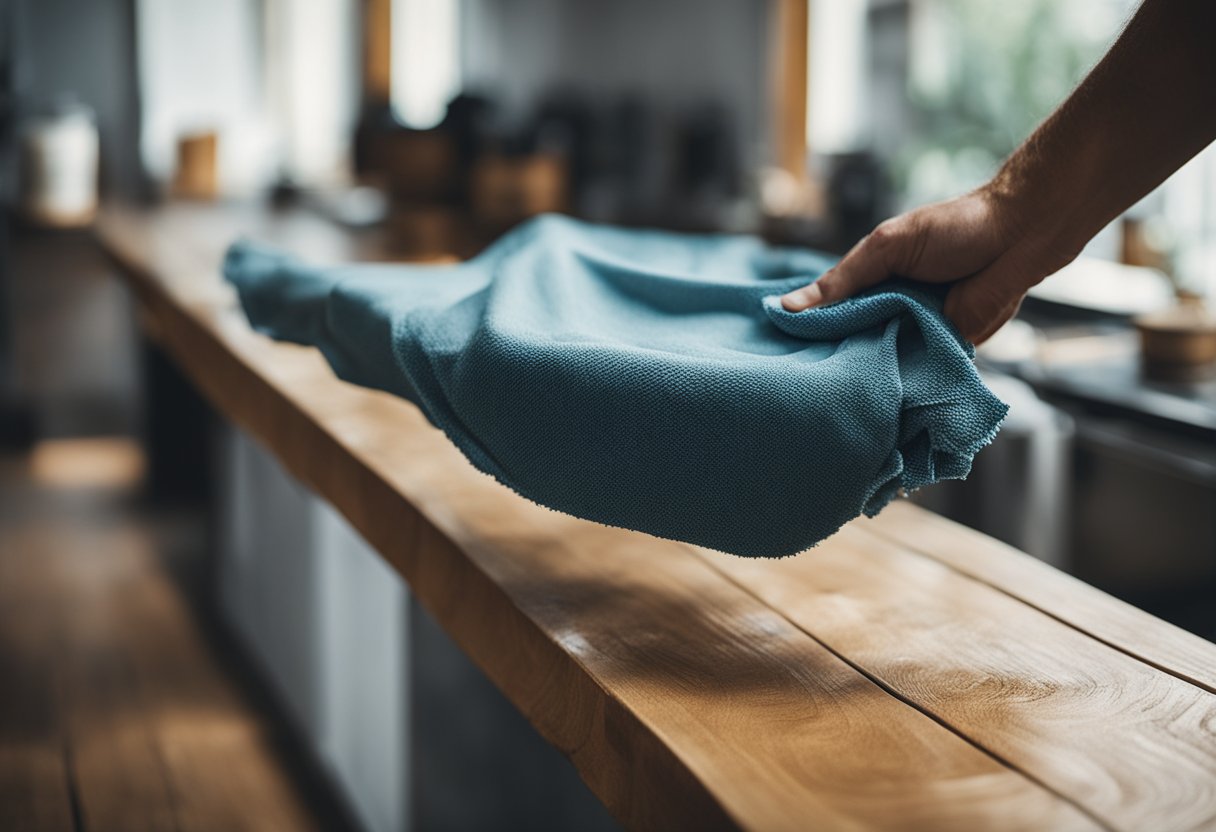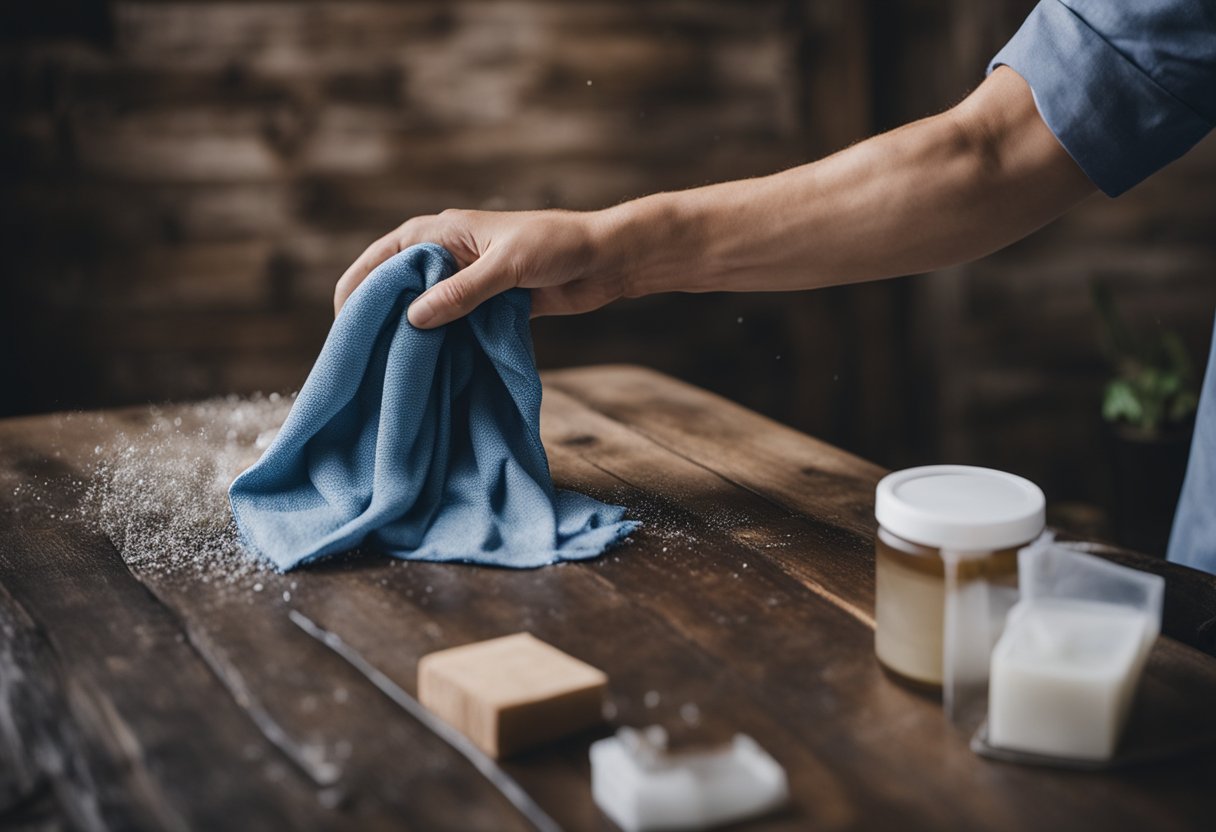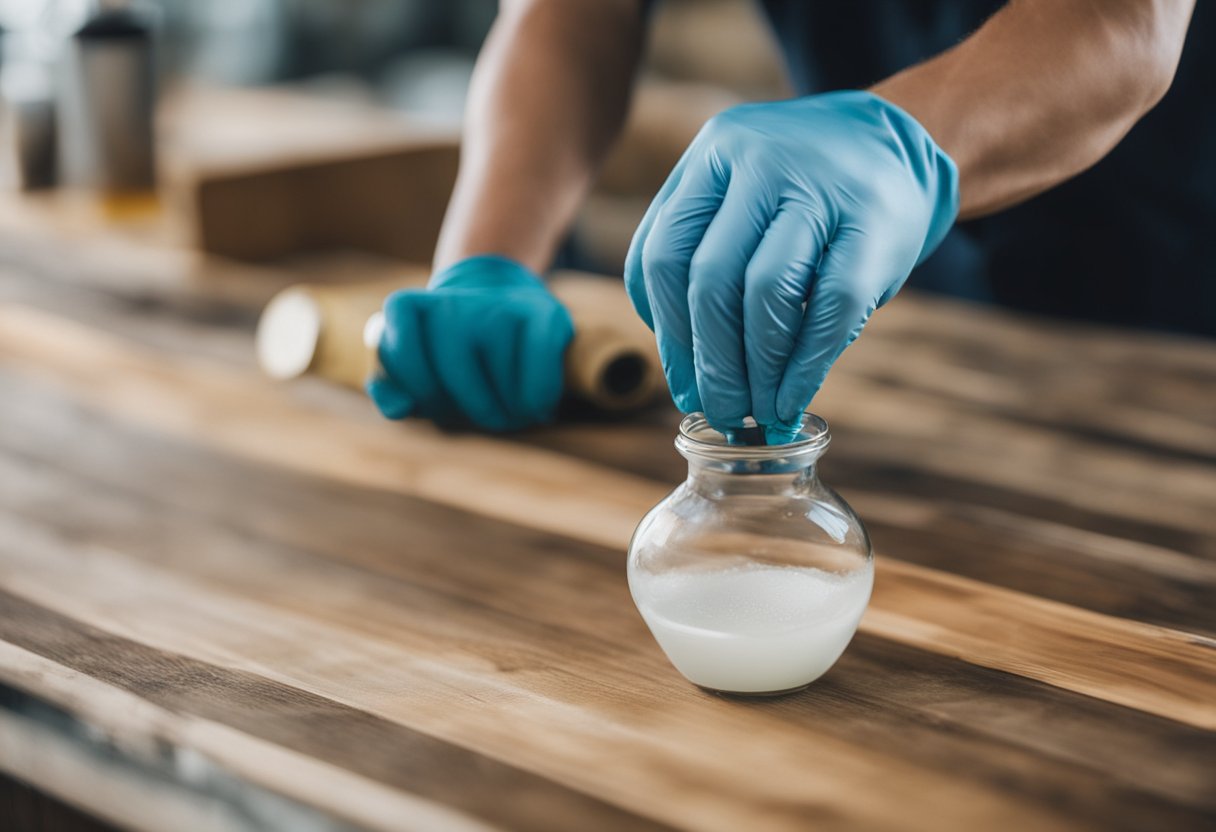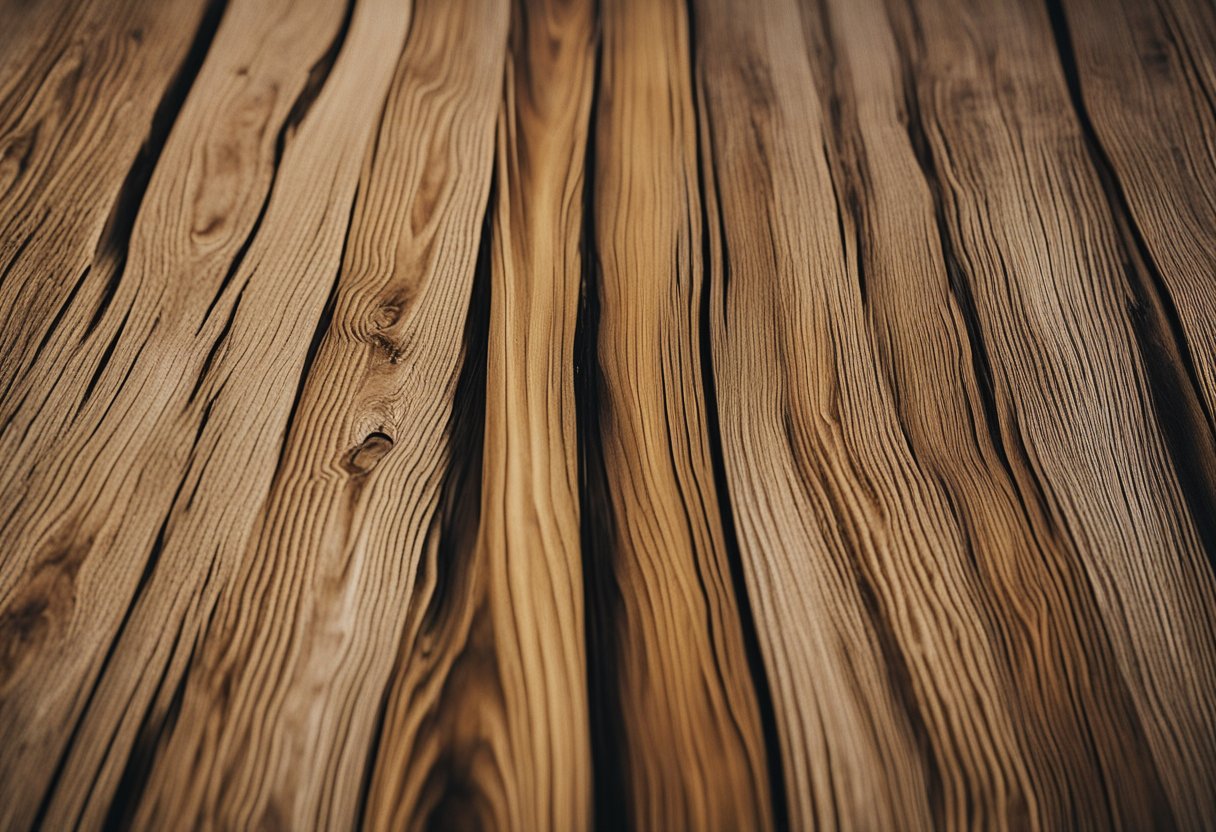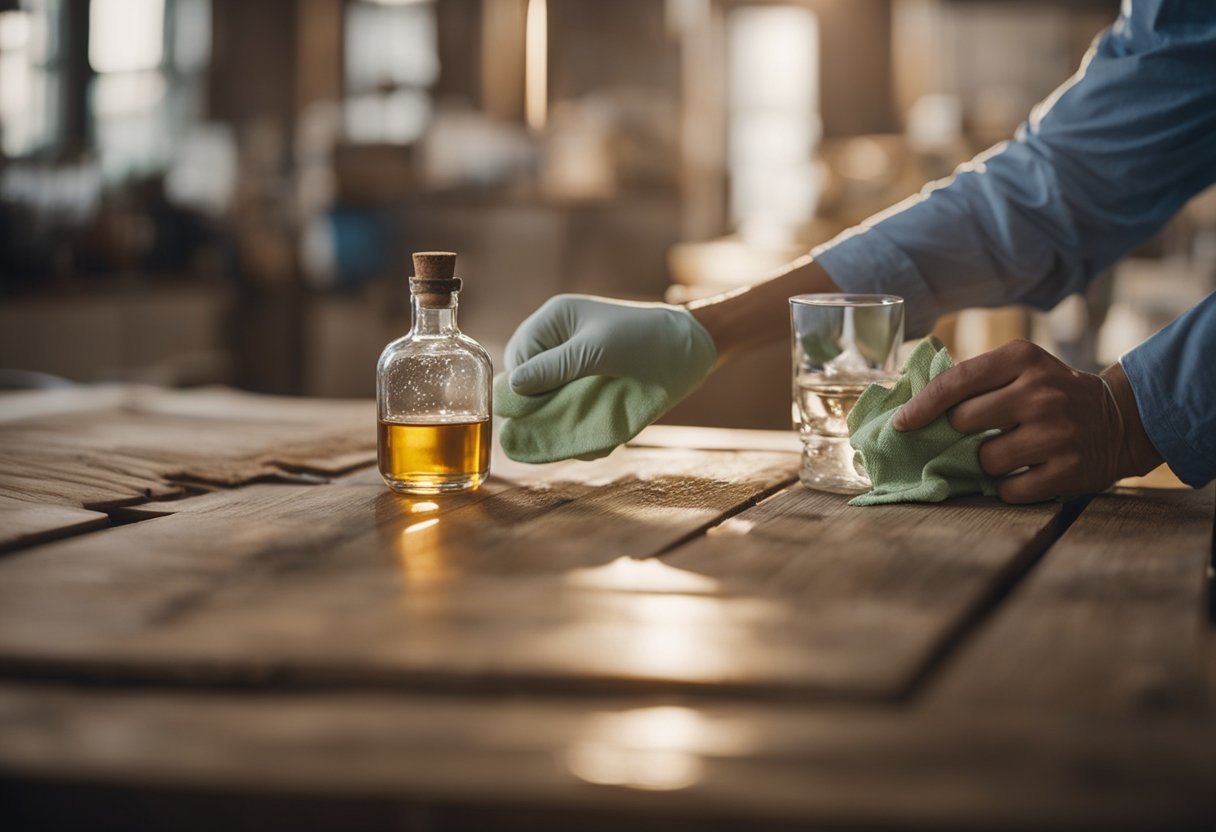I have researched the topic of using isopropyl alcohol to clean wood before painting. This is a common question among DIYers who are looking for an effective way to prepare their wood surfaces for painting. In this article, I will provide you with a clear and concise answer to this question, as well as other related topics that you may find helpful.
Understanding Isopropyl Alcohol
Before we dive into whether or not isopropyl alcohol can be used to clean wood before painting, let’s first understand what it is. Isopropyl alcohol, also known as rubbing alcohol, is a common household cleaning agent that is used for a variety of purposes. It is a colorless, flammable liquid that has a strong odor and is commonly used as a disinfectant.
Preparation Before Painting
When it comes to painting wood, proper preparation is key to achieving a smooth and even finish. This includes cleaning the surface of any dirt, dust, and debris that may be present. While isopropyl alcohol can be an effective cleaning agent for many surfaces, it may not be the best choice for cleaning wood. Let’s explore why that is the case in the next section.
Key Takeaways
- Isopropyl alcohol is a common household cleaning agent that is used for a variety of purposes.
- Proper preparation is key to achieving a smooth and even finish when painting wood.
- Isopropyl alcohol may not be the best choice for cleaning wood before painting.
Understanding Isopropyl Alcohol
https://www.youtube.com/watch?v=xsMes5WhtmY&embed=true
As a professional painter, I often get asked about the use of isopropyl alcohol to clean wood before painting. Isopropyl alcohol, also known as rubbing alcohol, is a common household disinfectant that is widely available and inexpensive. It is a versatile cleaning agent that can be used for a variety of purposes, including cleaning surfaces before painting.
Isopropyl alcohol is a type of alcohol that is commonly used as a solvent and disinfectant. It is a clear, colorless liquid with a strong odor. Isopropyl alcohol is highly flammable, so it is important to use caution when handling it. It is also important to note that isopropyl alcohol is not safe for consumption and should not be ingested.
When it comes to cleaning wood before painting, isopropyl alcohol can be an effective cleaning agent. It is a fast-drying solvent that evaporates quickly, which makes it ideal for cleaning surfaces before painting. It can help to remove dirt, grime, and other contaminants that may be present on the surface of the wood.
However, it is important to use isopropyl alcohol with caution when cleaning wood. Isopropyl alcohol can be harsh on some types of wood finishes, so it is important to test it on a small, inconspicuous area of the wood before using it on the entire surface. It is also important to use a soft cloth or sponge when cleaning with isopropyl alcohol to avoid damaging the wood.
In summary, isopropyl alcohol can be an effective cleaning agent for wood surfaces before painting. However, it is important to use it with caution and to test it on a small area of the wood before using it on the entire surface. It is also important to use a soft cloth or sponge when cleaning with isopropyl alcohol to avoid damaging the wood.
Preparation Before Painting
https://www.youtube.com/watch?v=5bVksnELL1M&embed=true
Before painting, it’s essential to prepare the surface, especially when it comes to wood. Proper preparation ensures that the paint adheres well to the surface, resulting in a smooth, even finish. Here are the steps that I recommend for preparing wood before painting.
Inspect the Surface
The first step is to inspect the surface for any imperfections, such as cracks, holes, or dents. These should be filled with wood filler and sanded down until smooth. Any loose paint should also be removed using a scraper or sandpaper.
Sanding and Dust Removal
Sanding the surface is necessary to create a smooth, even surface for painting. Sandpaper with a grit of 120 to 150 is ideal for sanding wood. After sanding, it’s essential to remove the sanding dust using a vacuum cleaner or a tack cloth. The tack cloth is a sticky cloth used to wipe down the surface, removing any remaining dust particles.
Cleaning the Surface
Cleaning the surface is the final step in preparation before painting. Isopropyl alcohol is an effective cleaner for wood surfaces. It evaporates quickly, leaving no residue, and is safe to use on most wood surfaces. To clean the surface, I recommend mixing equal parts of isopropyl alcohol and water in a spray bottle. Spray the solution onto the surface and wipe it down with a clean cloth.
In conclusion, proper preparation is essential before painting wood surfaces. Inspect the surface, sand it down, remove the dust, and clean it with isopropyl alcohol and water. These steps will ensure that the paint adheres well to the surface, resulting in a smooth, even finish.
Cleaning Wood with Isopropyl Alcohol
https://www.youtube.com/watch?v=gUjSPz3aijE&embed=true
As a woodworker, I often get asked if it is safe to use isopropyl alcohol to clean wood before painting. The answer is yes, you can use isopropyl alcohol to clean wood surfaces before painting.
Isopropyl alcohol is a powerful solvent that evaporates quickly, making it perfect for cleaning wood surfaces. It can remove dirt, grime, and other contaminants from the surface of the wood, leaving it clean and ready for painting.
To use isopropyl alcohol to clean wood, you can dilute it with water and put it in a spray bottle. You can then spray the solution onto the wood surface and wipe it down with a clean cloth. Alternatively, you can use a clean cloth to apply the solution directly to the wood surface and wipe it down.
It is important to note that isopropyl alcohol is a strong solvent, and it can damage some finishes. Therefore, it is recommended that you test the solution on a small, inconspicuous area of the wood surface before applying it to the entire surface.
In conclusion, using isopropyl alcohol to clean wood surfaces before painting can be an effective way to prepare the surface for the job. However, it is important to use it with caution and test it on a small area first to avoid any damage to the wood surface.
Safety Precautions
When using isopropyl alcohol to clean wood before painting, it is important to take some safety precautions. While isopropyl alcohol is generally safe to use, it is still a flammable substance and should be handled with care.
Firstly, it is important to wear gloves when handling isopropyl alcohol to avoid skin irritation. Additionally, it is important to use isopropyl alcohol in a well-ventilated area to avoid inhaling the fumes.
It is also important to note that isopropyl alcohol is highly flammable and should be kept away from heat sources or open flames. This means that you should avoid smoking or using any electrical devices that could cause a spark while using isopropyl alcohol.
Finally, it is important to use a clean towel or cloth when applying isopropyl alcohol to the wood. This will help to avoid any cross-contamination and ensure that the wood is properly cleaned before painting.
By following these safety precautions, you can safely use isopropyl alcohol to clean wood before painting and ensure that your painting project is a success.
Effect on Different Surfaces
When it comes to using isopropyl alcohol to clean wood before painting, it’s important to understand the effect it can have on different surfaces. Isopropyl alcohol is a powerful solvent that can dissolve many materials, including some types of paint, so it’s important to use it with caution.
Wood
Isopropyl alcohol can be used to clean unfinished wood before painting, but it should not be used on finished wood surfaces. The alcohol can dissolve the finish and cause damage to the wood. If you’re unsure whether your wood surface is finished or unfinished, test a small, inconspicuous area first before using isopropyl alcohol.
Plastic
Isopropyl alcohol is safe to use on most types of plastic, but it can cause damage to some types, such as polycarbonate and acrylic. If you’re unsure about whether your plastic surface can withstand isopropyl alcohol, test a small area first before using it.
Glass
Isopropyl alcohol is safe to use on glass surfaces and can help to remove any dirt or grime that may be present. However, it should not be used on tinted or coated glass, as it can damage the coating.
Metal
Isopropyl alcohol can be used to clean most types of metal surfaces before painting. However, it should not be used on aluminum surfaces, as it can cause pitting and corrosion.
Hard Surfaces
Isopropyl alcohol can be used to clean hard surfaces such as countertops, floors, and cabinets before painting. However, it should not be used on sanded surfaces, as it can dissolve the sanding dust and cause a rough surface.
Hardwood Floors
Isopropyl alcohol should not be used on hardwood floors, as it can dissolve the finish and cause damage to the wood. Instead, use a mild soap and water solution to clean hardwood floors before painting.
Overall, isopropyl alcohol can be a useful tool for cleaning surfaces before painting, but it’s important to use it with caution and test a small area first before using it on a larger surface.
Alternative Cleaning Solutions
https://www.youtube.com/watch?v=mkHKXOIUV5w&embed=true
While isopropyl alcohol is a great solution for cleaning wood before painting, there are other alternatives that can be used as well. These alternatives include water, vinegar, mineral spirits, and denatured alcohol. Each of these cleaning solutions has its own benefits and drawbacks.
Water
Water is a readily available cleaning solution that can be used to clean wood before painting. It is a safe and non-toxic option that is gentle on the wood. However, it may not be effective at removing tough stains or grease from the wood.
Vinegar
Vinegar is another effective cleaning solution that can be used to clean wood before painting. It is a natural and non-toxic option that can help remove dirt, grime, and old wax buildup. To use vinegar as a cleaning solution, mix ⅓ cup of vinegar with a gallon of warm water and apply with a clean cloth or sponge.
Mineral Spirits
Mineral spirits are a popular cleaning solution used by woodworkers to remove grease and oily residue from the surface of the wood. They are also effective at aiding in the absorption of stain and paint. However, mineral spirits are flammable and should be used with caution.
Denatured Alcohol
Denatured alcohol is another effective cleaning solution that can be used to clean wood before painting. It is a strong solvent that can help remove tough stains and grease from the wood. However, it is also flammable and should be used with caution.
In addition to these cleaning solutions, there are also a variety of cleaning products and dishwashing liquids that can be used to clean wood before painting. It is important to choose a cleaning solution that is appropriate for the type of wood you are working with and the type of stain or grease you need to remove.
Post Cleaning Steps
Once you have cleaned the wood surface with isopropyl alcohol, it is important to let it dry completely before painting. This will ensure that the paint adheres properly and does not peel or bubble off. The drying time will depend on the humidity and temperature of the room, but it usually takes about 30 minutes to an hour.
After the wood has dried, you can apply a topcoat to protect the paint and give it a beautiful finish. A clear topcoat can help enhance the color of the paint and add a glossy or matte finish. You can choose from various types of topcoats, such as lacquer, polyurethane, or varnish, depending on your preference and the type of wood you are painting.
If you are cutting the wood after painting, make sure to use a sharp blade to avoid chipping or peeling the paint. You can also use a sandpaper to smooth out any rough edges or imperfections.
Overall, using isopropyl alcohol to clean wood before painting can help ensure that the paint adheres properly and results in a beautiful finish. By following these post cleaning steps, you can enjoy a flawless paint job with no problems.
Professional Advice
https://www.youtube.com/watch?v=MIl2yTBjLWQ&embed=true
As a painter with years of experience, I am often asked if isopropyl alcohol can be used to clean wood before painting. My answer is yes, but with some caveats.
Professionals often use isopropyl alcohol to clean wood before painting because it is a fast-drying solvent that removes any residue, oils, or grains that could interfere with the paint job. It also helps to remove any dust or debris that may have accumulated on the surface. However, customers should be aware that the smell of isopropyl alcohol can be quite strong, so proper ventilation is necessary during the job.
When using isopropyl alcohol to clean wood before painting, it is important to use a soft, lint-free cloth to avoid scratching the surface. It is also important to test a small, inconspicuous area first to ensure that the wood does not react negatively to the alcohol.
Overall, isopropyl alcohol can be an effective tool for cleaning wood before painting, but it should be used with caution. If you are unsure about using isopropyl alcohol, it is always best to consult with a professional painter for advice.
Frequently Asked Questions
What is the best way to clean wood before painting?
The best way to clean wood before painting is to remove any dust, dirt, and debris from the surface. You can use a clean, damp cloth to wipe the surface of the wood. If the wood is particularly dirty, you can use a mild soap and water solution to clean it. After cleaning, make sure to let the wood dry completely before painting.
Can you use isopropyl alcohol to clean wood before painting?
Yes, you can use isopropyl alcohol to clean wood before painting. It is a great cleaner because it evaporates quickly and leaves no residue. However, it is important to use it in moderation as it can dry out the wood and cause damage.
Is isopropyl alcohol safe for wood?
Isopropyl alcohol is safe for wood in small quantities. It is important to use it in moderation as it can dry out the wood and cause damage. It is also important to avoid using it on painted or varnished surfaces as it can damage the finish.
Is denatured alcohol better than isopropyl alcohol for cleaning wood?
Denatured alcohol is better than isopropyl alcohol for cleaning wood because it is a stronger solvent. It can remove more stubborn stains and dirt from the wood. However, it is also more toxic and flammable than isopropyl alcohol, so it should be used with caution.
Will rubbing alcohol damage painted wood?
Rubbing alcohol can damage painted wood because it is a strong solvent that can dissolve the paint. It is important to avoid using rubbing alcohol on painted or varnished surfaces.
How to fix alcohol spills on wood?
If you spill alcohol on wood, it is important to clean it up immediately to prevent damage. Use a clean, dry cloth to blot up as much of the spill as possible. Then, use a mild soap and water solution to clean the area. Dry the area completely before applying any finish or paint. If the spill has caused damage to the wood, you may need to sand and refinish the area.

Hi, I’m Sal Muller of Tooltrip.com. My DIY experience led me to understand essential power tools for home projects. Tooltrip.com guides enthusiasts and professionals in choosing right tools for any job. I provide concise top tool reviews for easier, efficient DIY.

